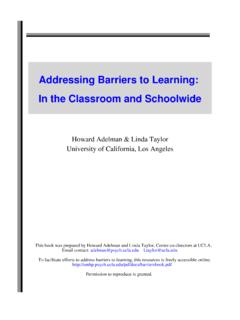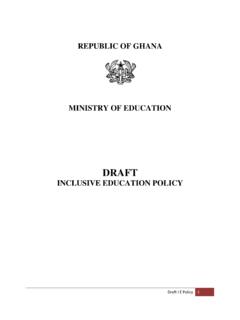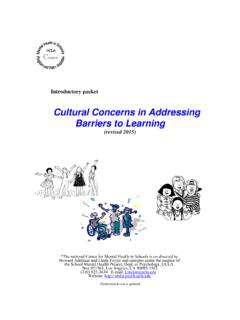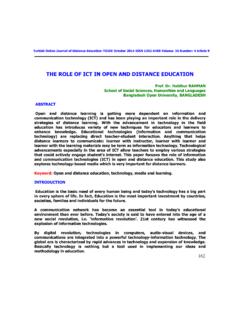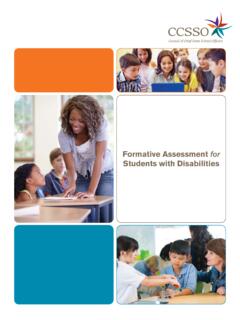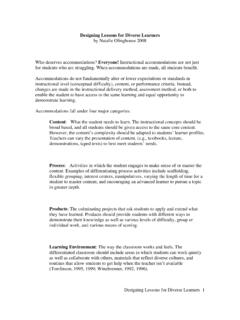Transcription of Designing for Special Education - NAC Architecture
1 Designing FOR Special EDUCATIONBEST PRACTICES FOR Special NEEDS learning FACILITIESiiDESIGNING FOR Special EDUCATIONACCOMMODATING EACH CHILD1 Designing FOR Special EDUCATIONOUR APPROACH As school designers, we at NAC Architecture are passionate about creating great spaces for all students to learn. What makes this challenging is that each student is an individual, with needs specific to their abilities, preferences, and even moods. What is a perfect environment for one student, at one time, trying to learn one thing, is certain to be an imperfect environment for another student. To accommodate the widest possible range of needs, our solution is to design for variety and group of students is more diverse than Special Education students.
2 These young people have an extremely wide variety of needs, and deserve to be fully accommodated. Legally, per the Individuals with Disabilities Act (IDEA) of 1990, Special Education students are entitled to a free and appropriate public Education in the least restrictive environment. These important terms highlight our duty to accommodate each child s specific book provides planning and design principles pulled from NAC Architecture s collective experience, as well as expert Special educators, and examples from around the world. It represents our goal to spread this expertise in Designing facilities for Special Education to help more children benefit from well-designed educational environments that support them in realizing their potential with Riedel AIA, ALEP, LEED AP, Principal Alyson Mahoe Research & Experience Development Department 2 Designing FOR Special EDUCATIONINCLUSION AND SPECIALIZATION Providing the best educational support for Special Education and medically fragile students requires collaboration between teachers, therapists, medical professionals, and parents.
3 It is important for all participants to build trusting relationships, keep the lines of communication open, and strive to increase family the proper training is critical for teachers to focus on the inclusion of students with disabilities. Despite federal and state efforts to standardize teaching, the Special Education teacher ultimately is responsible for employing best practices and implementing the appropriate intervention growing from students current levels of performance, and meeting their social, emotional, behavioral, and intellectual inclusivity is important, many schools are not fully equipped or prepared to serve medically fragile children.
4 Sometimes criticized for segregation, highly specialized schools can often give students with intensive needs the best Education possible while supporting them medically. These schools have an increased ability to adapt the learning experience to suit each child s individual SPECIALIZED SCHOOLS CAN OFTEN GIVE STUDENTS WITH INTENSIVE NEEDS THE BEST Education POSSIBLE WHILE SUPPORTING THEM FOR Special EDUCATIONDESIGN CONSIDERATIONS FOR THE BUILT ENVIRONMENT4 Designing FOR Special EDUCATIONCONSIDERATIONS FOR THE BUILT ENVIRONMENTAs an Education design firm, NAC understands the importance of Designing schools where all students can achieve their highest level of potential despite any physical or mental limitations.
5 There is not a one-size-fits-all model, so each school design must incorporate the best available information about current and future student populations in order to accommodate as much diversity as design considerations for Special Education are good practice for all Education environments. The Massachusetts Education research nonprofit, CAST (Center for Applied Special Technology), promotes Universal Design for learning (UDL), which posits that the learning environment and curriculum should be designed to accommodate the full diversity of students. The principles of UDL focus on minimizing barriers and maximizing learning , going beyond requiring access to providing support for all learners.
6 While critical for Special needs students, ensuring great classroom acoustics, easy connections to outdoor spaces, and straightforward wayfinding benefits FOR Special EDUCATIONDESIGNING FOR Special EDUCATIONIDEA ELIGIBILITY Students diagnosed with one or more of the disabilities listed below, and who require Special Education instruction and/or related services, are IDEA-eligible. States may choose to add additional categories to the list in the federal statute, and the statutory language may vary somewhat from state to state as well. For example, a student between the ages of three and five years who is evaluated as having an intellectual disability, emotional disturbance, specific learning disability, or autism may be described as non-categorical early childhood eligible at the state federal list is as follows.
7 >Autism >Deaf-blindness >Emotional disturbance >Hearing impairment >Intellectual disability >Multiple disabilities >Orthopedic impairment >Other health impairments >Specific learning disability >Speech or language impairment >Traumatic brain injury >Visual impairmentDIGNITY AND USER EXPERIENCEWhen Designing for students with disabilities, it is important to maintain their dignity. Accommodations should avoid separating them from their peers in the instructional setting, drawing unusual attention to them, or limiting their Education . One should not design for the diagnosis, but rather for the best predictable user experience. Due to the variety of sensory differences, it is necessary to consider the potential for severe reactions to sensory elements.
8 Understanding and thoughtfully considering the possibilities is essential when creating an environment that enhances learning for all students. Our goal is to rethink design to encompass a broad spectrum of sensory, cognitive, and social differences, offering opportunities to foster social inclusion and enhance ACOUSTICS Acoustics are among the most important factors when Designing a Special Education school. The shape and surfaces of a room have a direct impact on acoustical comfort and speech intelligibility. While good classroom acoustics benefit all children, they are critical for students with auditory processing disorders, speech and language delay, or attention issues.
9 Thoughtful material choices and layout can significantly reduce noise distraction, including background noise, reverberation, and sound transfer throughout the Robinson School (designed for dyslexia), NAC Architecture7 Designing FOR Special EDUCATIONDESIGNING FOR Special EDUCATION5/8 thickgypsum boarddata conduit /power cablesteel stud framingOUTSIDEINSIDE2-1/2 thick spray foam insulationvapor permeableair barrier2-1/2 thick rigid insulationgalvanizedsteel sidingBACKGROUND NOISEB ackground noise can come from inside or outside the building, and should not exceed 35 dBA. Noise from the exterior, such as traffic, equipment, or kids at play, can negatively affect learning , particularly for young Special Education students.
10 Elementary school students have not fully developed the ability to differentiate background noise from primary sound sources, such as a teacher s voice. This experience is more pronounced for individuals with increased sensory , controlling outside noise is fairly straightforward. Good building practices for thermal insulation, such as sealed insulated window units, wall insulation, and mass, are effective in reducing the impact of exterior noise on the interior. Accordingly, exterior equipment (heat pumps for air conditioning systems, electrical generators, etc.) should be located or separated to prevent noise FOR Special EDUCATIONREVERBERATIONC ontrolling reverberation inside rooms is a key to creating great learning spaces, because excessive reverberation can directly reduce speech intelligibility and produce a buildup of noise.
